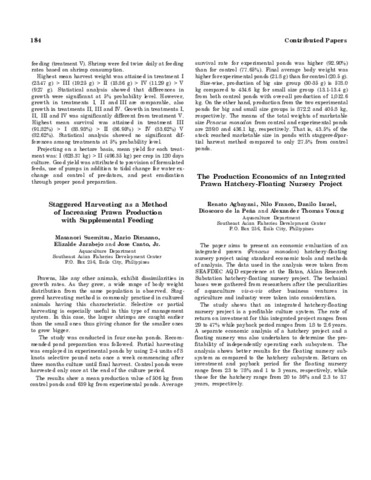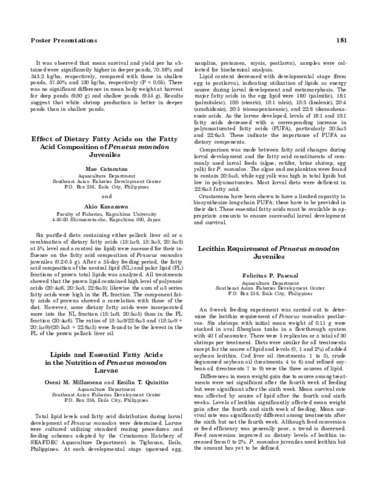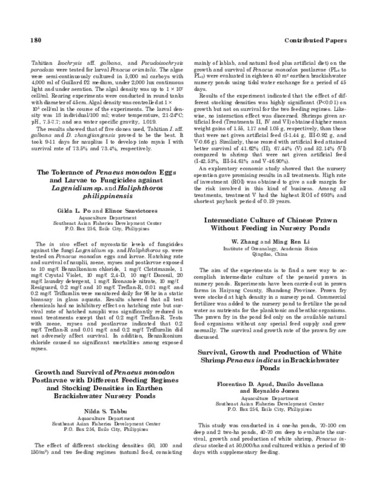Preliminary biological evaluation of some formulated feeds for P. monodon
- Global styles
- MLA
- Vancouver
- Elsevier - Harvard
- APA
- Help

Date
1977Page views
1,934ASFA keyword
AGROVOC keyword
Taxonomic term
Metadata
Show full item record
Share
Abstract
Rice bran is widely used by fish farmers as supplementary feed while soybean cake is used both as feed and as fertilizer in fishponds. Both fish meal and shrimp head have been found acceptable as feed ingredients. However, not much is known of the acceptability and efficiency of a mixture of these ingredients as feed for Penaeus monodon larvae. Ninety 127-day old P. monodon were measured for length and weight and were randomly divided into nine aquaria each containing 20 liters of water. These were fed lampirong for two months previous to the study. There were three replications for each treatment. Length, weight, and survival rates were used to compare the efficiency of the diets. Weighed amounts of pellets equivalent to 100% of the body weight were fed during the first three days and reduced to 50% thereafter. A stopwatch was used to determine the length of time that elapsed before the shrimps would approach the pellet. Ten shrimps approximately 4 months in age were placed in 10 liters of water in a 25-liter aquarium. Two grams of each pellet type were placed simultaneously on opposite sides of the aquarium. The time that elapsed from the moment the pellets sunk to the bottom up to the time that any one shrimp approached the pellets was recorded. The group fed the imported pellets gained the most. Those fed FP-2s-77 elongated faster than those fed FP-1s-77. Survival rate of those fed FP-2s-77 was 37% while those fed imported pellets was 73%. Both 1s and 2s pellets disintegrated in water easily but the imported pellets were stable even after six hours in water. The attractability test for the pellets showed that the prawns were more readily attracted to the pellets 1s and 2s than to the imported pellets.
Description
Extended abstract only.
Suggested Citation
Pascual, F., & Bandonil, L. (1977). Preliminary biological evaluation of some formulated feeds for P. monodon. SEAFDEC Aquaculture Department Quarterly Research Report , 1(1), 32-33. http://hdl.handle.net/10862/2281
Type
ArticleCollections
Related items
Showing items related by title, author, creator and subject.
-
Staggered harvesting as a method of increasing prawn production with supplemental feeding
Suemitsu, M.; Dimaano, M.; Jarabejo, E.; Canto, J. Jr. (Aquaculture Department, Southeast Asian Fisheries Development Center, 1985)Prawns, like any other animals, exhibit dissimilarities in growth rates. As they grow, a wide range of body weight distribution from the same population is observed. Staggered harvesting method is commonly practised in ... -
Lipids and essential fatty acids in the nutrition of Penaeus monodon larvae
Millamena, O.M.; Quinitio, E.T. (Aquaculture Department, Southeast Asian Fisheries Development Center, 1985)Total lipid levels and fatty acid distribution during larval development of Penaeus monodon were determined. Larvae were cultured utilizing standard rearing procedures and feeding schemes adopted by the Crustacean Hatchery ... -
The tolerance of Penaeus monodon eggs and larvae to fungicides against Lagenidium sp. and Haliphthoros philippinensis
Po, G.L.; Sanvictores, E. (Aquaculture Department, Southeast Asian Fisheries Development Center, 1985)The in vivo effect of mycostatic levels of fungicides against the fungi Lagenidium sp. and Haliphthoros sp. were tested on Penaeus monodon eggs and larvae. Hatching rate and survival of nauplii, zoeae, myses and postlarvae ...






